-
Higgs physics plays a significant role in the standard model (SM) testing and search for new physics beyond SM with higher precision. The theoretical and experimental study on the properties of the Higgs boson, including its couplings with SM particles, particularly fermions, has become a primary task of particle physics at the high energy frontier since it was discovered in 2012 at the LHC [1, 2], and considerable efforts have been made. The study of the process of decay of the Higgs boson to heavy quark pairs
bˉb andcˉc is important to test the SM and search for high precision new physics. Furthermore, useful information for the running mass effects in the Yukawa coupling can be obtained by analysing these decay processes. The decay width of Higgs boson into massless bottom quarks is known up to the next-to-next-to-next-to-next-to-leading order in QCD [3-5]. The differential decay width forh→bˉb has been computed to the next-to-next-to-leading order (NNLO) QCD in [6, 7], and next-to-next-to-next-to-leading order in [8] in the limit where the mass of the bottom quark is neglected. The corrections keeping the exact bottom quark mass have been computed to NNLO in [9-12]. The hadronic decays of Higgs boson to the bottom quarks, light quarks, and gluons at NNLO have been calculated in [13]. For the two loop QCD corrections ofh→bˉb , the flavor-singlet contribution from the triangle top and bottom quark loop have to be included. These contributions from the top quark triangle loop are computed approximately using a large quark mass expansions formula [14], and the corresponding exact calculations are also obtained [15]. The calculations at the next-to-leading order (NLO) electroweak (EW) are also completed [16-18]. The measurements ofh→bˉb at LHC are finished [19, 20], and the signal strengthμh→bˉb=1.01± 0.12(stat.)+0.16−0.15(syst.) is compatible with SM.For the evaluation of Higgs boson coupling to the second generation quark,
h→cˉc is a process of great value. Owing to the absence of an observation of Higgs decays to the charm quark, there are some bounds on the charm quark Yukawa coupling. An indirect search for the decay of the Higgs boson to charm quarks via the decay toJ/ψγ is presented at the LHC [21-23]. A direct search for the Higgs boson, produced in association with a vector boson (W or Z), and decaying to a charm quark pair is performed by CMS collaboration [24] and ATLAS collaboration [25], respectively. This result is the most stringent limit to date for the inclusive decay of theh→cˉc . Both ATLAS and CMS collaborations present novel methods for charm-tagging. To test the SM and search for new physics in high precision, the theoretical predictions and experimental measurements on SM Higgs couplings should be completed as precisely as possible. To achieve this, we finish the exact calculation forh→cˉc up to NNLO QCD including the flavor-singlet contributions from the triangular loops of the bottom and top quarks and those at the NLO EW. However, owing to the discovery of the Higgs boson, the search for additional (pseudo) scalar bosons beyond the SM has attracted increasing interest in collider physics. The axion-like particles (ALPs) are a hypothetical (pseudo) scalar that naturally arises in many extensions of the SM as pseudo Nambu-Goldston bosons. The ALP parameter space has been intensively explored [26-28], covering a wide energy range [29-34]. These experimental searches allow access to several orders of magnitude in the ALP masses and couplings [35], where astrophysics and cosmology impose constraints in the sub-KeV mass range and the most efficient probes in the MeV-GeV range are obtained from experiments acting on the precision frontier [36]. Another aim of this study is to evaluate the ALPs that dominantly couple to the up type quark [37], e.g., charm quark, and obtain some constraints on the corresponding parameters from the ALP associate production with the charm quark pair in the Higgs decay.This paper is organized as follows. In Sec. II, we study the decay width of
h→cˉc within the SM. First, we use renormalized matrix elements where the QCD coupling is defined in the¯MS scheme, whereas the charm quark mass and the Yukawa coupling are defined in the on-shell scheme. For the order ofα2s , we calculate the exact flavor-singlet contributions. To obtain reliable corrections to the decay width ofh→cˉc , we express the on-shell Yukawa coupling in terms of the¯MS Yukawa coupling. At the end of this section, after including the NLO EW corrections, we obtain the decay width ofh→cˉc and compare it with that ofh→bˉb . In Sec. III, we evaluate the ALP associate production with the charm quark pair in Higgs decay. Finally, a brief summary is given. -
Within the SM, the Higgs interactions with quarks are obtained by considering the Yukawa interactions
−LY=¯URhuQT(iτ2)Φ−¯DRhdQT(iτ2)˜Φ+h.c.,

(1) where Φ denotes a complex
SU(2)L doublet Higgs field with hyper chargeY=1/2 ; τ is the usual2×2 Pauli matrix;˜Φ=iτ2Φ∗ .QT=(UL,DL) , where U and D represent three up- and down-type quarks; andhu,d represents Yukawa matrices. By choosingΦ=(0,v+h)T/√2 , we obtain−Lhfˉf=y0,fhfˉf,f=u,d,s,c,b,t,

(2) where
y0,f=m0,f/v is the bare Yukawa coupling constant andm0,f is the bare mass of the corresponding quark. The Higgs vacuum expectation valuev=(√2GF)−1/2 withGF the Fermi constant.In our following analysis, we start by using the renormalized matrix elements where the QCD coupling constant
αs is defined in the¯MS scheme, whereas the charm quark massmc and the related Yukawa coupling constantyc are defined in the on-shell scheme. Up to NNLO QCD, the decay width of the processh→cˉc can be written as followsΓ=ΓLO+αs(μ)˜Γ1+α2s(μ)˜Γ2+α2s(μ)2πln(μ2m2c)[116Nc−nf+13]˜Γ1,

(3) where µ is the renormalization scale.
Nc andnf denote the number of the color and the number of the massless quarks, respectively. The decay width at the leading order (LO) can be expressed as followsΓLO=NCy2c8πm2h(m2h−4m2c)3/2,

(4) where
mh andmc denote the on-shell mass of the Higgs boson and charm quark, respectively.˜Γ1 and˜Γ2 respectively represent the scaled next-to-leading order (NLO) and NNLO decay width ofh→cˉc by the factor outαs . At the NLO QCD, the scaled decay width˜Γ1 can be expressed as follows [38]˜Γ1=ΓLOCFδ1,

(5) where
CF=(N2c−1)/2/Nc , andδ1=1π{A(β)β−3+34β2−13β416β3ln(x)−3(1−7β2)8β2},

(6) with
β=√1−4m2c/m2h ,x=(1−β)/(1+β) andA(β)=(1+β2){4Li2(x)+2Li2(−x)+2ln(β)ln(x)+3ln(11+β)ln(x)}−3βln(41−β2)−4βln(β).

(7) At the NLO QCD, the large logarithm related to the ratio of the charm-Higgs mass appears. This effect can be clearly shown in the limit
mc→0 , i.e.,δ1≃32π(32−lnm2hm2c).

(8) The large logarithm
ln(m2h/m2c) should be absorbed in the running charm quark mass in the Yukawa coupling as discussed below.ΓLO ,˜Γ1 and˜Γ2 do not depend on µ. The µ dependence of the last term in Eq. (3) can be obtained from the renormalization group equation.At the NNLO QCD, the subtraction term of double-real radiation corrections and real-virtual corrections were computed in [39-42]. For the double-virtual corrections, the scaled decay width
˜Γ2 receives the flavor-singlet and non-singlet contribution. The flavour-singlet contributions fromh→cˉc (Fig. 1(a)) andh→cˉcg (Fig. 1(b)) are both UV and IR finite separately. Because we keep the non-zero internal quark massmf (f=c,b,t ), these three kinds of massive quarks, which couple to the Higgs in the triangle loop, contribute to the decay width ofh→cˉc . For the calculation of the case where the Higgs couples to the internal charm quark, i.e., equal masses associated with the inner and outer fermion line, and that of the flavor non-singlet contribution, the strategy and formulas can be found in [9, 43-46]. Here, we focus on discussing the flavor-singlet contribution toh→cˉc where the Higgs boson couples to the bottom or top quark. For Fig. 1(a) withQ′=b or t, we calculate the exact results using the formula and techniques of [15] where the Mathematica packages PolyLogTools [47], HPL, and GINAC library are necessary. For Fig. 1(b), we finish the calculation independently. In our numerical analysis, we choosemh= 125.09 GeV,v≃ 246.2 GeV,mc= 1.68 GeV,mb= 4.78 GeV,mt= 173.34 GeV,αs(mZ)=0.118 , andmZ= 91.2 GeV [48]. In Table 1, we list our results˜ΓFSQ′ for the flavor-singlet contribution withQ′=b , t whereα2s is factored out in the partial decay width. It is found that˜ΓFSb is considerably smaller than˜ΓFSt . For the case where top quark appears in the triangle loop,mc⩽ , and\tilde{\Gamma}_{t}^{\rm FS} can be calculated to the leading order in the charm quark mass as an expansion in the inverse powers of the top quark mass [14]. It is found that under this approximation,\tilde{\Gamma}_{t}^{\rm FS}\simeq 0.7417 MeV which is very close to the exact result. For the triangular loop related to the bottom quark, this approximation is unreliaable. At the NNLO QCD, the other two interesting sub-processes areh\to c\bar{c} c\bar{c} andh\to b \bar{b} c\bar{c} . The results for the scaled decay width\tilde{\Gamma}_{c\bar{c} c\bar{c}} and\tilde{\Gamma}_{b\bar{b} c\bar{c}} where\alpha_s^2 is also factored out are listed in Table 1. Obviously,\tilde{\Gamma}_{c\bar{c} c\bar{c}} is significantly smaller than\tilde{\Gamma}_{b\bar{b} c\bar{c}} , but for\tilde{\Gamma}_{b\bar{b} c\bar{c}} , the contribution from the interaction between the Higgs boson and bottom quark is dominant. As a result, the contribution fromh\to b \bar{b} c\bar{c} should not be included in the decay width ofh\to c\bar{c} . Up to the NNLO QCD, the ratio of the flavor-singlet contribution withQ' = b , t to the total decay width is approximately 4%.
Figure 1. The flavor-singlet
{\cal{O}}(\alpha_s^2) contributions toh \to c \bar{c} (a) andh \to c \bar{c}g (b) withQ' = t, b, c .\tilde{\Gamma}_{b}^{\rm FS}/{\rm{MeV} } 

\tilde{\Gamma}_{t}^{\rm FS}/{\rm{MeV} } 

\tilde{\Gamma}_{c\bar{c} c\bar{c} }/{\rm{MeV} } 

\tilde{\Gamma}_{b\bar{b} c\bar{c} }/{\rm{MeV} } 

−0.0482 0.7411 0.4262 3.4495 Table 1. Results for the scaled decay width
\tilde{\Gamma}_{b}^{FS} ,\tilde{\Gamma}_{t}^{FS} ,\tilde{\Gamma}_{c\bar{c} c\bar{c}} and\tilde{\Gamma}_{b\bar{b} c\bar{c}} .It is known that under the on-shell renormalization scheme for the Yukawa coupling between the SM Higgs and massive quarks, the large logarithm of the fermion-Higgs boson mass ratio can be obtained in the radiative corrections [49]. Therefore, it is not a good idea to study the decay width in terms of the on-shell Yukawa coupling when
m_c / m_h \ll 1 . When using the\rm\overline{MS} Yukawa coupling\overline{y}_c(\mu)\, = \, \overline{m}_c(\mu)/v\; ,

(9) where
\overline{m}_c(\mu) is the running\rm \overline{MS} mass and\mu = m_h ; this kind of large logarithmic effects can be reduced by effectively absorbing all relevant large logarithms into the running mass related to the Yukawa coupling constant. In this study, to obtain reliable corrections to the decay width ofh\to c\bar c , we converted Yukawa coupling constanty_c defined in the on-shell scheme to\overline{y}_c in the\overline{\rm{MS}} scheme. The relation between on-shell massm_c and\overline{\rm{MS}} mass\overline{m}_c(\mu) can be written as follows [50]:m_c\, = \, \overline{m}_c(\mu)\; \Big[1+c_1(m_c,\mu)\frac{\alpha_s(\mu)}{\pi} +c_2(m_c,\mu) \Big(\frac{\alpha_s(\mu)}{\pi} \Big)^2 \Big]+{\cal{O}}(\alpha_s^3)\; ,

(10) where
\begin{aligned}[b] c_1\, =& C_{\rm F}\left(1+\frac{3}{4}L_c\right), \\ c_2\, = & C_{\rm F}^2\, \left[ \frac{121}{128}+3\zeta(2)\left(\frac{5}{8} - \ln2\right)+\frac{3}{4}\zeta(3) +\frac{27}{32}L_c+\frac{9}{32}L_c^2\right] \\ &-N_{\rm C} C_{\rm F} \, \left[-\frac{1111}{384}+\frac{\zeta(2)}{2}(1-3\ln2)+\frac{3}{8}\zeta(3)-\frac{185}{96}L_c\right.\\&\left.-\frac{11}{32}L_c^2\right] -C_{\rm F} T_{\rm F} n_f \, \left[\frac{71}{96}+\frac{1}{2}\zeta(2)+\frac{13}{24}L_c+\frac{1}{8}L_c^2\right] \\ & -C_{\rm F} T_{\rm F} \, \left[\frac{143}{96}-\zeta(2)+\frac{13}{24}L_c+\frac{1}{8}L_c^2\right], \end{aligned}

(11) with
T_{\rm F} = 1/2 ,L_c = \ln({\mu^2}/{m_c^2}) ,\zeta(2) = {\pi^2}/{6} and\zeta(3) = 1.20205690\cdots .To compute the
\overline{\rm{MS}} Yukawa coupling\overline{y}_c(\mu) for the arbitrary scale µ, we use the solution of the renormalization group equation for\overline{m}_c(\mu) at two-loops\begin{aligned}[b] \overline{m}_c(\mu)\, = & \overline{m}_c(\mu_0)\bigg(\frac{\alpha_s(\mu)}{\alpha_s(\mu_0)} \bigg)^{1/\beta_0} \bigg \{ 1+\frac{(\gamma_{1}/\beta_0-1/\beta_1)}{\pi\beta_0^2} \\&\times[\alpha_s(\mu)-\alpha_s(\mu_0) ]+O(\alpha_s^2) \bigg\}, \end{aligned}

(12) where
\gamma_{1} = \frac{303-10n_f}{72}, \; \; \; \beta_0 = \frac{33-2n_f}{12},\; \; \; \beta_1 = \frac{153-19n_f}{24}.

(13) For the on-shell c-quark mass, we used
\overline{m}_c(\mu = \overline{m}_c) = 1.28 GeV [48] as the input in Eq. (10), and obtainedm_c = 1.68 GeV. The results for the dependence of\overline{m}_c(\mu) on µ are displayed in Fig. 2.Inserting Eq. (10) into Eq. (3), we obtain the decay width for
h\to c\bar c calculated in terms of the\overline{\rm{MS}} Yukawa coupling\begin{aligned}[b] \overline{\Gamma} =& \overline{y}_c^2(\mu)\hat{\Gamma}_{0}^{c\bar{c}}\Bigg[1+\frac{\alpha_s(\mu)}{\pi}(\gamma_1^{c\bar{c}}+2c_1)\\&+ \left(\frac{\alpha_s(\mu)}{\pi}\right)^2(\gamma_2^{c\bar{c}}+2c_1\gamma_1^{c\bar{c}}+2c_2-5c_1^2)\Bigg]\; .\end{aligned}

(14) The
\gamma_1^{c\bar{c}} ,\gamma_2^{c\bar{c}} ,\hat{\Gamma}_{0}^{c\bar{c}} ,\hat{\Gamma}_{1}^{c\bar{c}} , and\hat{\Gamma}_{2}^{c\bar{c}} conventions are similar to those used in [9]. Here,\gamma_1^{c\bar{c}} = C_F\, \delta_1 \pi . In Eq. (14), it can be observed that the large log term\ln (m_h^2/m_c^2) that appears in the\alpha_s order correction is analytically reduced by the log term,\ln (\mu^2/m_c^2) , in the\overline{\rm{MS}} Yukawa coupling if\mu \sim m_h . At the NNLO QCD, the corresponding numerical results are listed in Table 2 for three different renormalization scales. In Fig. 3, we show the dependence of\overline{\Gamma}_{I}^{c\bar c} (I = LO, NLO, NNLO) on µ. Here, we use\overline{\Gamma}_{\rm LO}^{c\bar c} ,\overline{\Gamma}_{\rm NLO}^{c\bar c} and\overline{\Gamma}_{\rm NNLO}^{c\bar c} to respectively denote the LO, NLO, and NNLO QCD corrections in terms of the\overline{\rm{MS}} Yukawa coupling. The µ dependence is significantly decreased at the NNLO QCD. We also show the differential distribution of thec\bar{c} invariant mass in Fig. 4, where sub-processh\to c\bar c c\bar c is not included to avoid confusion. In the smallM_{c\bar{c}} region, the NNLO QCD contributions are larger than the NLO QCD corrections because the soft and/or collinear gluon radiation becomes significant.\mu\; =\; m_h/2 

\mu\; =\; m_h 

\mu\; =\; 2m_h 

\overline{\Gamma}_{\rm LO}^{c\bar{c} }/{\rm{MeV} } 

0.1033 0.0916 0.0823 \overline{\Gamma}_{\rm NLO}^{c\bar{c} }/{\rm{MeV} } 

0.1153 0.1103 0.1049 \overline{\Gamma}_{\rm NNLO}^{c\bar{c} }/{\rm{MeV} } 

0.1162 0.1148 0.1125 Table 2. Inclusive decay width of
h\to c\bar{c} in terms of\overline{\rm{MS}} Yukawa coupling.
Figure 4. (color online) Distribution
{\rm d}\overline{\Gamma}^{c\bar{c}}/{\rm d}M_{c\bar{c}} of thec\bar{c} invariant mass at LO (short-dashed), NLO (long-dashed), and NNLO (solid) QCD corrections. The short-dashed, long-dashed, and solid lines correspond to the scale choice\mu = m_h , whereas the shaded bands show the effect of varying the renormalization scale between\mu = m_h/2 and\mu = 2 m_h .To obtain the precise result for
h\to c\bar{c} , the NLO EW corrections should be included along with the NNLO QCD corrections. The corresponding decay width at the NLO EW can be written as follows\Gamma_{\rm EW}^{c\bar c}\, = \, \overline{\Gamma}_{\rm LO}^{c\bar c} \; \Big[ {\cal{O}}_{\rm QED}^{c\bar c}\, + \, {\cal{O}}_{\rm Weak}^{c\bar c} \Big] \; .

(15) The NLO QED correction,
{\cal{O}}_{\rm QED}^{c\bar c} , has a similar form as that of the NLO QCD, i.e.,{\cal{O}}_{\rm QED}^{c\bar c}\, = \, \alpha\, Q^2_c\, \delta_1 \; ,

(16) where α is the QED coupling, and we choose
\alpha(m_Z) = 1/127.934 [48].Q_c denotes the electric charge of the charm quark. The coefficient\delta_1 at the NLO QED is similar to that at the NLO QCD. The large logarithm\ln (m_h^2/m_c^2) in\delta_1 at the NLO QED can be absorbed in the running quark mass as in the QCD corrections. For the NLO weak correction{\cal{O}}_{\rm Weak}^{c\bar c} , there are several studies on this topic [16, 17]. In this study, we adopt the approximation of [18].\begin{aligned}[b] {\cal{O}}_{\rm Weak}^{c\bar c}\, = & \frac{\alpha}{16 m_W^2 \pi}\Bigg \{k_c m_t^2+m^2_W\Bigg[-5+\frac{3}{s^2_W}\ln c_W^2\Bigg]\\&-8m_Z^2(6v^2_{Zc\bar c}-a^2_{Zc\bar{c}})\Bigg \}\; , \end{aligned}

(17) where
v_{Zc\bar{c}} = I^c_3/2-Q_c s_W^2 anda_{Zc\bar{c}} = I^c_3/2 withI_3^c denoting the third component of the electroweak isospin of the charm quark, and the coefficientk_{c} = 1 .s_W = \sin\theta_W andc_W = \cos\theta_W with the\theta_W the weak angle, and we choosem_W = 80.358 GeV, ands_W^2 = 0.2233 [48] in our numerical calculations. Finally, we obtain the total decay width of theh\to c\bar{c} including the NNLO QCD and NLO EW corrections as follows\Gamma_{\rm total}^{c\bar c}\, = \, \overline{\Gamma}^{c\bar c}_{\rm NNLO}+ \Gamma_{\rm EW}^{c\bar c}\; .

(18) To combine the precise theoretical predictions and experimental measurements for
h\to f\bar f withf = c , b, we can abstract some useful information of the running mass effect in the Yukawa couplings. To achieve this, we list the results for the decay width ofh\to c\bar c at the NNLO QCD and NLO EW, and that ofh\to b\bar b together with their ratio in Table 3 for three renormalization scales. Ratio{\Gamma}^{b\bar{b}}_{\rm total}/{\Gamma}^{c\bar{c}}_{\rm total} is approximately twenty. Therefore, it is possible to measure theh\to c\bar c events at the LHC because approximately1.5\times10^5 h\to b\bar b events have been observed with data samples corresponding to the integrated luminosity of79.8\; {\rm fb}^{-1} via the Wh and Zh associated production [19, 20]. Therefore, approximately2.8\times 10^4 h\to c\bar c events will be produced in the similar way but with300\; {\rm fb}^{-1} integrated luminosity, which make it possible to observeh\to c\bar{c} . However, the small decay width ofh\to c\bar c makes it advantageous to search for new physics that may induce relatively large interactions related to the charm quark, for example, the ALP discussed in the next section.\mu\; =\; m_h/2 

\mu\; =\; m_h 

\mu\; =\; 2m_h 

{\Gamma}^{c\bar{c} }_{\rm total}/{\rm{MeV} } 

0.1165 0.1151 0.1129 {\Gamma}^{b\bar{b} }_{\rm total}/{\rm{MeV} } 

2.4248 2.3990 2.3533 {\Gamma}^{b\bar{b} }_{\rm total}/{\Gamma}^{c\bar{c} }_{\rm total} 

20.8137 20.8427 20.8441 Table 3. Total decay width
{\Gamma}^{f \bar f}_{\rm total} ofh\to f \bar f withf\bar{f} = c\bar{c}, b\bar{b} at the NNLO QCD and NLO EW, together with their ratio. -
We begin by considering a general ALP with flavor violating couplings to the right-handed up-quarks [37]. To describe such a system, the most general effective field theory is given by the following lagrangian
\begin{aligned}[b] -{\cal{L}} \, = \,& \frac{1}{2}(\partial_{\mu}a)(\partial^{\mu}a)-\frac{m_a^2}{2}a^2+\frac{\partial_{\mu}a}{f_a} \Big[(c_{uR})_{ij}\bar{u}_{Ri}\gamma^{\mu}u_{Rj}\\&+c_{\Phi} \Phi^{\dagger}i\overleftrightarrow{D}_{\mu}\Phi\Big] -\frac{a}{f_a}\Bigg[c_g \frac{g_3^2}{32\pi^2} G^{a}_{\mu \nu} \tilde{G}^{\mu \nu a}\\& +c_W\frac{g_2^2}{32\pi^2} W_{\mu \nu}^I \tilde{W}^{\mu\nu I}+c_B \frac{g_1^2}{32\pi^2}B_{\mu \nu}\tilde{B}^{\mu\nu}\Bigg]\; , \end{aligned}

(19) where a and Φ denote the ALP and Higgs field, respectively.
g_1 ,g_2 ,g_3 are theU(1)_Y ,SU(2)_L andSU(3)_c gauge couplings of the SM, respectively, whereasB_{\mu \nu} ,W_{\mu \nu}^I , I = 1, 2, 3, andG^b_{\mu \nu} , b = 1, ...8, are their corresponding field-strength tensors.\tilde{B}_{\mu\nu} = 1/2 \epsilon_{\mu\nu\alpha\beta} B^{\alpha\beta} , ..., represent the corresponding dual field.U_{Ri} withi = 1,2,3 denotes the right-handed SM up-quark of the ith generation.f_a can be treated as a free parameter.c_{\Phi} ,c_g ,c_W , andc_B are the Wilson coefficients, andc_{uR} is a hermitian matrix. In this model, it is assumed that the ALP is a pseudo Nambu-Goldstone boson of the spontaneous breaking of a globalU(1) symmetry, and that its couplings to the leptons, SM quark doublets, and right-handed down-type quarks vanish. The operator(\partial^{\mu}a/{f_a}) \Phi^{\dagger}i\overleftrightarrow{D}_{\mu}\Phi can be traded using Higgs field redefinition [31].We then evaluate the ALP production in association with the charm quark pair in the Higgs boson decay. The differential decay width of the
h\to c\bar{c} a process where a denotes the ALP can be obtained as follows{\rm d}\Gamma_{h\to c\bar{c} a} \, = \, \frac{1}{2 m_h}\, |{\cal M}|^2\, {\rm d}{\cal{L}} ips_3\; ,

(20) where
{\cal{L}}ips_3 is the Lorentz invariant phase space of the final three particles. The matrix element square can be expressed as follows\begin{aligned}[b] |{\cal M}|^2 \, = \,& \frac{2 y_c^2\,\, |(c_{uR})_{22}|^2}{f_a^2}\, \Bigg \{ {m_h}^2\Bigg({x_c}+{x_{\bar{c}}}-1-\frac{4{m_c}^2}{{m_h}^2}+\frac{{m_a}^2}{{m_h}^2}\Bigg)\\&+ \frac{1}{{m_h}^2} \Bigg[ \frac{-{m_c}^2{m_h}^2(x_c-x_{\bar{c}})^2}{(1-{x_c}) (1-{x_{\bar{c}}})} \\& +\frac{{m_a}^2}{{m_h}^2} \Bigg( \frac{{m_c}^2(4{m_c}^2+{m_h}^2(1-2x_{c}))}{(1-{x_{c}})^2} \\&+\frac{{m_c}^2(4{m_c}^2+{m_h}^2(1-2x_{\bar{c}}))}{(1-{x_{\bar{c}}})^2} \\& +\, \frac{2{m_c}^2(4{m_c}^2-{m_h}^2({x_c}+{x_{\bar{c}}}-1))}{(1-{x_c}) (1-{x_{\bar{c}}})} \Bigg)\Bigg ] \Bigg \} , \end{aligned}

(21) where
m_a is the ALP mass.x_c = 2E_c/m_h andx_{\bar{c}} = 2E_{\bar{c}}/m_h withE_c (E_{\bar{c}} ), the c(\bar c ) quark energy in Higgs rest frame. In Eq. (21), the dependence of the ALP mass appears in the form{\cal{O}}(m_a/m_h)^0+{\cal{O}}(m_a/m_h)^2 , where(m_a/m_h)^2 is a tiny quantity form_a\ll m_h so that the height of the distribution is not sensitive to the ALP mass. In the following numerical calculations, we factor out|(c_{uR})_{22}|^2/f_a^2 from\Gamma_{h\to c\bar{c} a} , i.e.,\Gamma_{h\to c\bar{c} a}\, = \, \frac{|(c_{uR})_{22}|^2}{f_a^2}\, \tilde{\Gamma}_{h\to c\bar c a}\; .

(22) The experiment searches on the ALP parameter spaces that is
m_a andf_a allow access to several orders of magnitude. The joint limit of these two parameters is given experimentally. Direct searches for the ALP and calculations of their effect on the cooling of stars and on the supernova SN1987A imposef_a\gtrsim 4\times 10^8 GeV [51]. The thermally produced ALP DM is allowed in sizable parts of the parameterm_a\gtrsim 154 eV [52]. In our analysis,f_a is treated as a free parameter that relaxes the restriction ofm_a . We choosem_a = 0.01, \; 10, \; 30 GeV. The results for the differential distribution with respect toM_{c\bar c} are shown in Fig. 5. Because there is no exact measurement forh\to c\bar c , to obtain some constrain on the parameters, we set the condition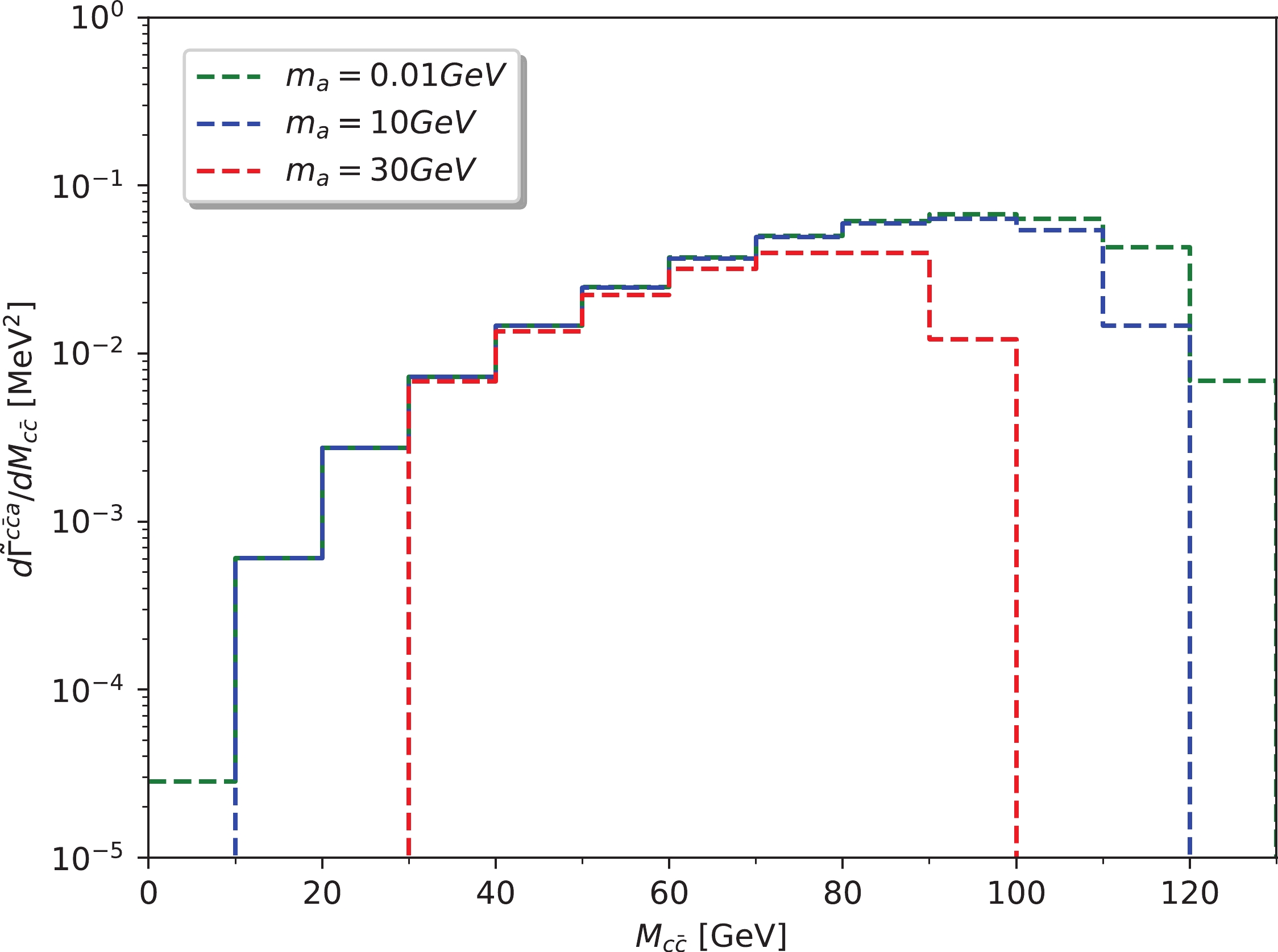
Figure 5. (color online) Distribution
{\rm d}\tilde{\Gamma}^{c\bar{c}a}/{\rm d}M_{c\bar{c}} of thec\bar{c} invariant mass.\Gamma_{h\to c\bar{c} a}\, \leqslant 1{\text{%}}\, {\Gamma}^{c\bar{c}}_{\rm total}\; , \; \; \;{\rm{and}}\; \; \; 10{\text{%}}\, {\Gamma}^{c\bar{c}}_{\rm total}.

(23) The constraints for
|(c_{uR})_{22}|^2/f_a^2 with respect tom_a are shown in Fig. 6. A loose constrain for the larger ALP mass can be found. It is also interesting to search for the ALP via theh\to c\bar{c}a process in the future electron-positron collider, e.g. the Circular Electron-Positron Collider (CEPC) or International Linear Collider (ILC). By comparing the distribution of theh\to c\bar{c} background andh\to c\bar{c}a signal in Fig. 4 and Fig. 5, it can be observed that for the background, the distribution tends to be close to the Higgs mass, whereas the signal process does not. Therefore, for a rough estimation, we require that the invariant mass of c,\bar{c} be less than 110 GeV. Furthermore, we consider thee^+ e^- \to Zh process withZ\to e^+ e^-, \mu^+ \mu^- andh\to c\bar{c} orc\bar{c}a at\sqrt{s} = 250 GeV. The 3σ exclusion limit and 5σ discovery limit with the integrated luminosity of 250{\rm fb}^{-1} are shown in Fig. 7. When the high precision measurement ofh\to c\bar c is available, the realistic constrain for the ALP production inh\to c\bar c can be obtained.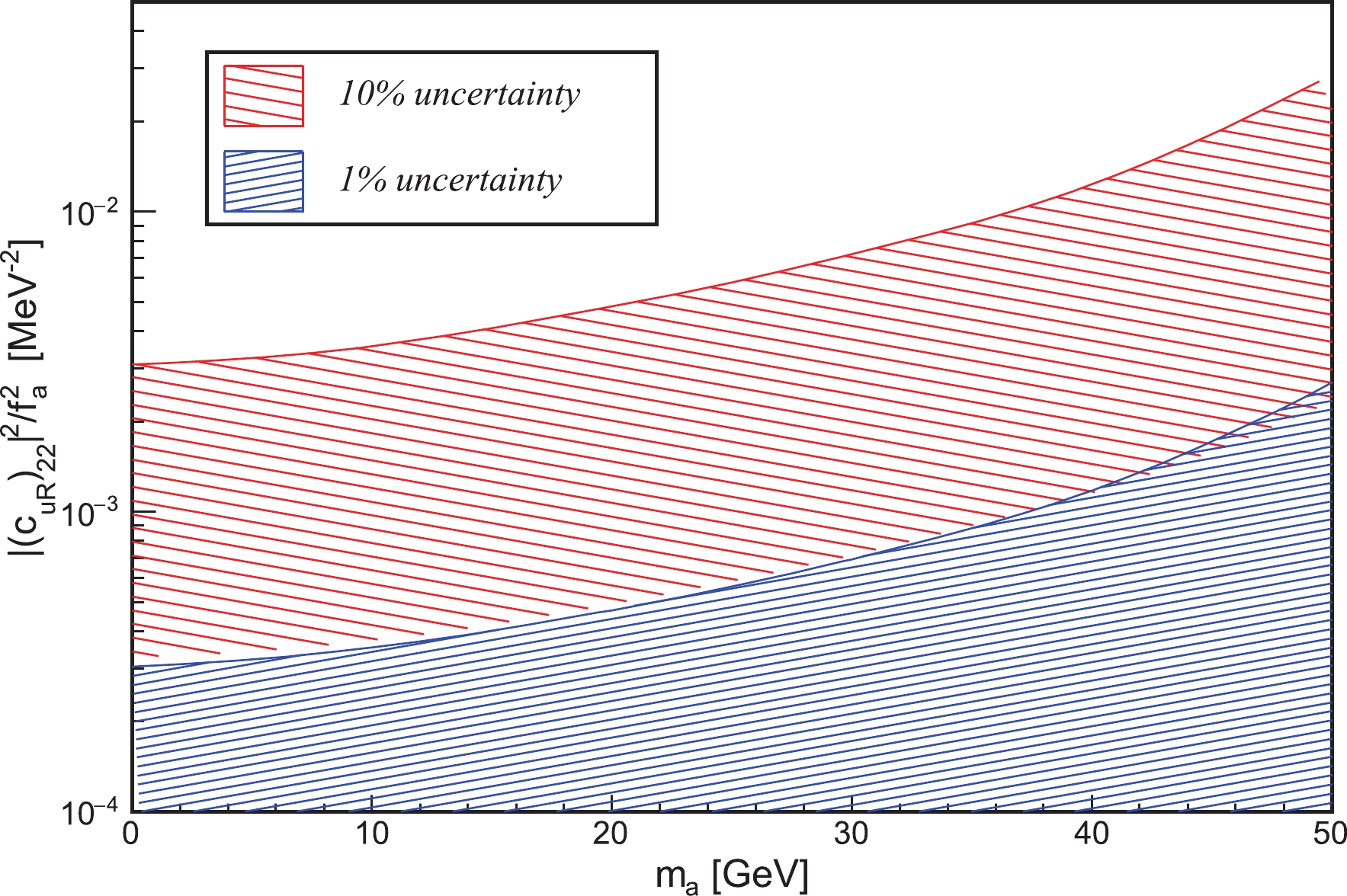
Figure 6. (color online) Constraints on
|(c_{uR})_{22}|^2/f_a^2 as a function ofm_a , resulting from the conditions\Gamma_{h\to c\bar{c} a} \leqslant 10{\text{%}}\, {\Gamma}^{c\bar{c}}_{\rm total} and\Gamma_{h\to c\bar{c} a}\, \leqslant 1{\text{%}}\, {\Gamma}^{c\bar{c}}_{\rm total} , with the allowed regions marked by red and blue, respectively. -
Measurements on the
h\to c\bar c with high statistics at the LHC are still in progress. More theoretical studies on this process are still necessary and significant. Moreover, after the discovery of the SM Higgs, the search for new (pseudo) scalar boson beyond the SM, e.g., ALP, has become a significant topic in particle physics. In this paper, we present the results of the decay widths forh\to c\bar{c} at the NNLO QCD and NLO EW corrections. For the flavor-singlet contributions where the Higgs boson coupled to the bottom and top quark appeared at an order of\alpha_s^2 , we provide the exact results, and find that the exact result of the top quark triangle is very close to the approximate result calculated to the large top quark mass expansion. The results for the Yukawa coupling defined in the\overline{\rm{MS}} scheme is more reliable and the large logarithmic effect related to the ratio of the charm-Higgs mass is reduced. Finally, we evaluate the ALP associate production with the charm quark pair, and the constrain for the related parameters is estimated by assuming a condition of Eq. (23). At the upgraded LHC, an increasing number of events on the Higgs boson decay will be accumulated, so that precise studies onh\to c\bar c and the search for new particles in the Higgs decay become possible. -
The authors thank Profs. W. Bernreuther, H. F. Li and Dr. L. Chen for their helpful discussions, and also thank Prof. F. Tramontano for providing us the code to calculate the virtual flavor-singlet triangle loop.
Precise evaluation of h→cˉc and axion-like particle production
- Received Date: 2021-04-20
- Available Online: 2021-09-15
Abstract: We study the decay of the SM Higgs boson to a massive charm quark pair at the next-to-next-to-leading order QCD and next-to-leading order electroweak. At the second order of QCD coupling, we consider the exact calculation of flavour-singlet contributions where the Higgs boson couples to the internal top and bottom quark. Helpful information on the running mass effects related to Yukawa coupling may be obtained by analyzing this process. High precision production for







 Abstract
Abstract HTML
HTML Reference
Reference Related
Related PDF
PDF












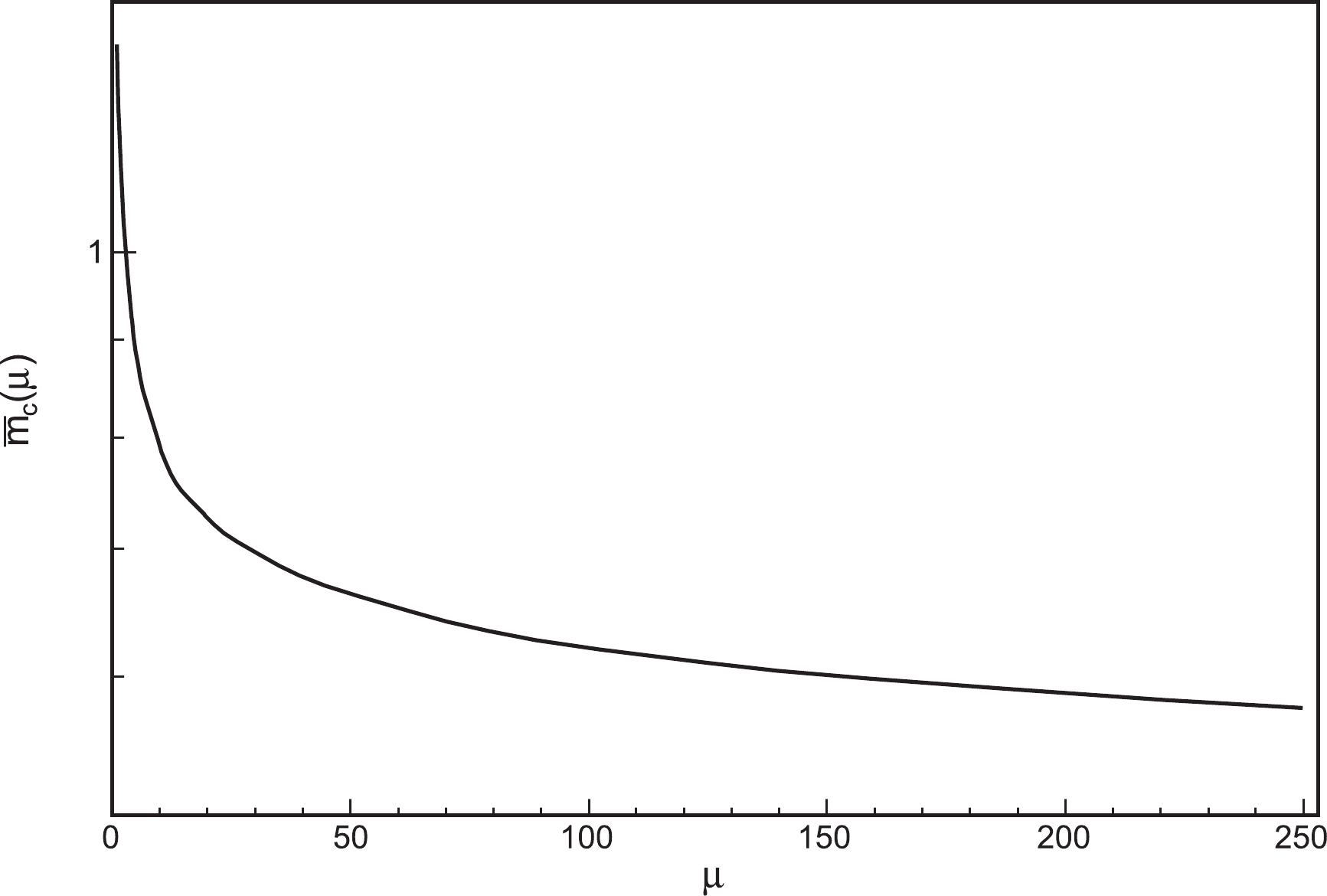
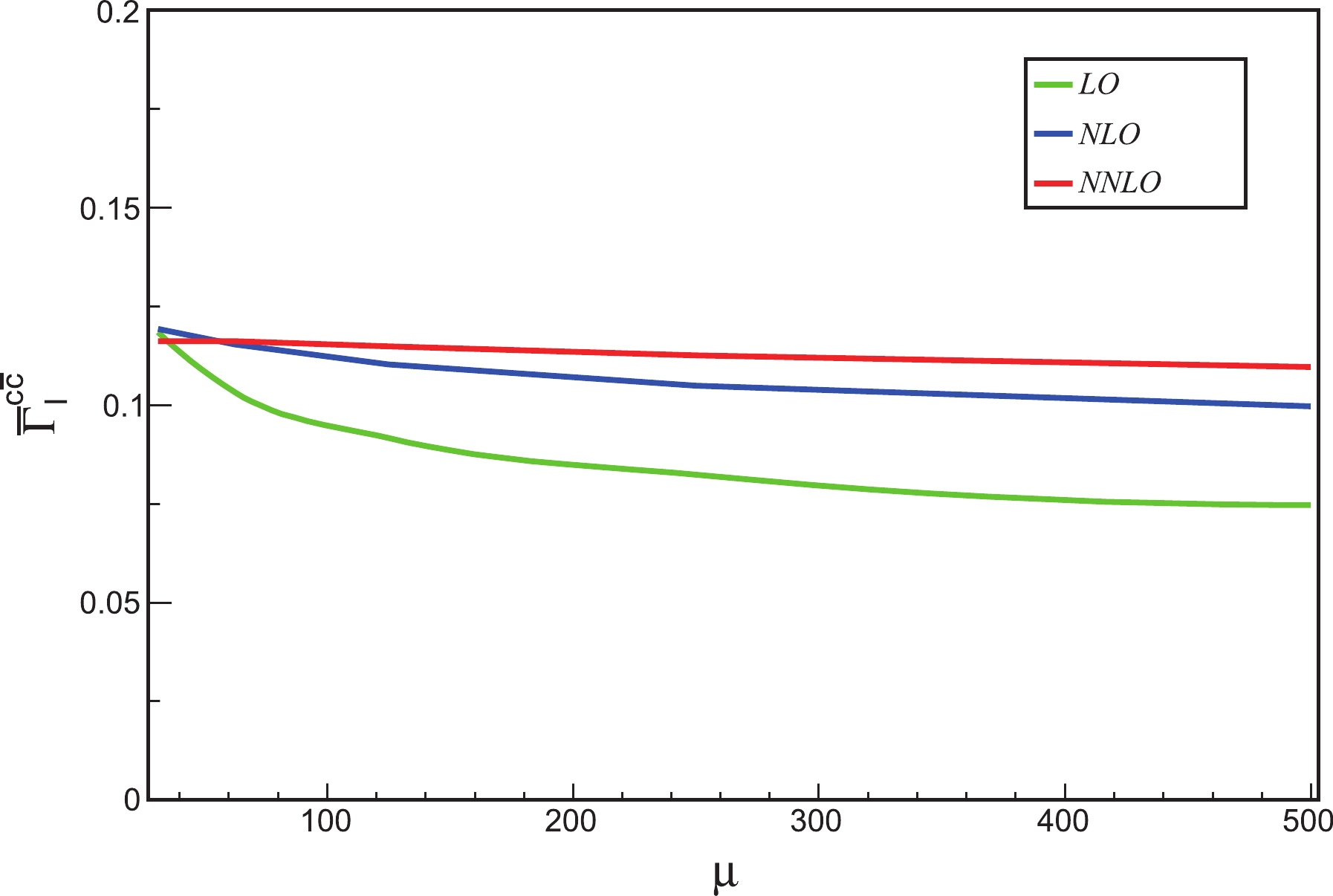
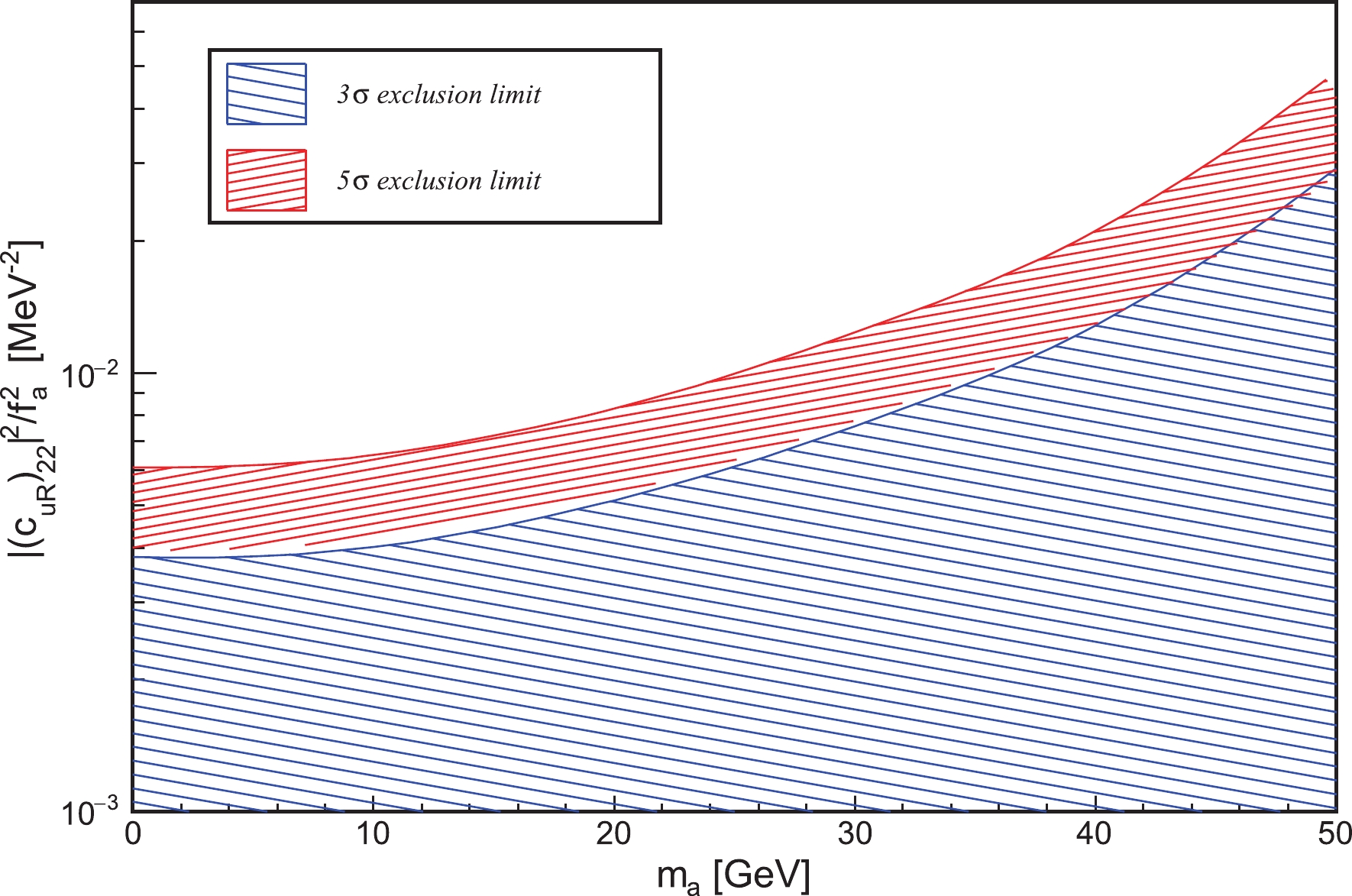



 DownLoad:
DownLoad: